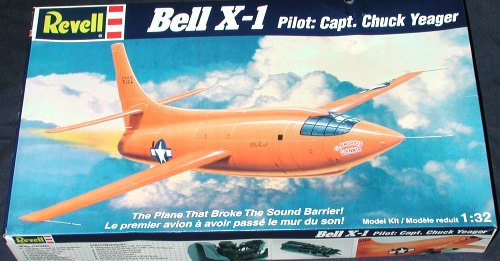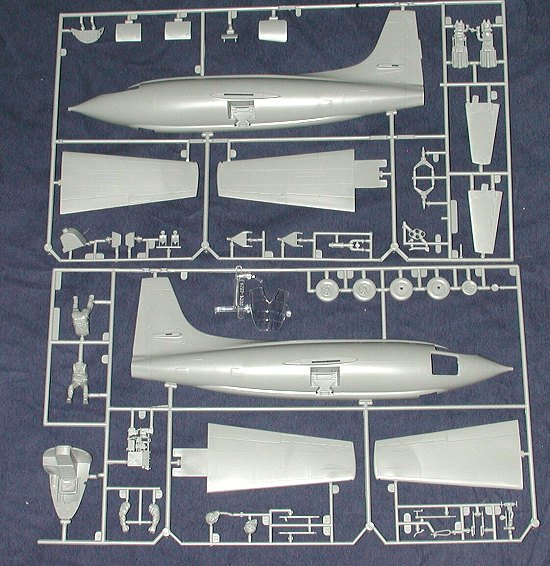
|
KIT: |
Revell 1/32 X-1 |
|
KIT # |
4565 |
|
PRICE: |
$14.00 MSRP |
|
DECALS: |
one option |
|
REVIEWER: |
|
|
NOTES: |

|
HISTORY |
On October 14, 1947, the Bell X-1 became the first airplane to fly faster than the speed of sound. Piloted by U.S. Air Force Capt. Charles E. "Chuck" Yeager, the X-1 reached a speed of 1,127 kilometers (700 miles) per hour, Mach 1.06, at an altitude of 13,000 meters (43,000 feet). Yeager named the airplane "Glamorous Glennis" in tribute to his wife.
Air-launched at an altitude of 7,000 meters
(23,000 feet) from the bomb bay of a Boeing B-29, the X-1 used its rocket
engine to climb to its test altitude. It flew a total of 78 times, and on
March 26, 1948, with Yeager at the controls, it attained a speed of 1,540
kilometers (957 miles) per hour, Mach 1.45, at an altitude of 21,900
meters (71,900 feet). This was the highest velocity and altitude reached
by a manned airplane up to that time.
Transferred from the U.S. Air Force to the National Air and Space
Museum.
Many important structural and aerodynamic
advances were first employed in the Bell X-1, including extremely thin
yet exceptionally strong wing sections and a horizontal stabilizer that
could be adjusted up and down to improve control, especially at transonic
(near the speed of sound) speeds. Because of the stabilizer's success,
later transonic military aircraft were designed with all moving
horizontal stabilizers as standard equipment.
The X-1's fuselage was shaped like a .50 caliber bullet. Even the
windscreen was specially faired to retain the bullet shape. The X-1
carried more than 230 kilograms (500 pounds) of flight test instruments.
|
THE KIT |

I'm not positive just when this kit was first released, but I'm thinking the late 1980s. The molding is of the raised panel line variety and it includes the usual excellent Revell/Monogram detailing that we have all come to expect. The clear canopy is quite transparent though a bit distorted. There is no flash, but sink areas are present on the side wall detail parts, gear door outside surfaces, inside of rudder pedals, and the hatch. These same parts as well as the landing gear suffer from ejector pin marks, some of which will not be easy to properly remove or fill. The kit comes with a full pilot figure to fill in some of the space in the cockpit. There is also a nice representation of the rocket engine, though little but the exhaust will be visible once the kit is completed.
 Instructions are the typical
modern version with eleven assembly steps. Part names are given as well as
any painting information in each of the steps. A painting guide is provided
with only the orange color having an FS 595 number. Markings are provided
for only one aircraft and that is the X-1 when it became the first plane to
break the sound barrier on 14 October, 1947. Though the red barred insignia
was introduced on 14 January 1947, it sometimes took a while for the change
to be made to all aircraft. From what I've been able to deduce, the X-1 was
wearing the new insignia when the sound barrier was broken so alternate
decals will be required. The Revell decals are very glossy, relatively
glossy and appear well printed. The insignia has too small a star on it as
the tips should reach out to the white bars and does not.
Instructions are the typical
modern version with eleven assembly steps. Part names are given as well as
any painting information in each of the steps. A painting guide is provided
with only the orange color having an FS 595 number. Markings are provided
for only one aircraft and that is the X-1 when it became the first plane to
break the sound barrier on 14 October, 1947. Though the red barred insignia
was introduced on 14 January 1947, it sometimes took a while for the change
to be made to all aircraft. From what I've been able to deduce, the X-1 was
wearing the new insignia when the sound barrier was broken so alternate
decals will be required. The Revell decals are very glossy, relatively
glossy and appear well printed. The insignia has too small a star on it as
the tips should reach out to the white bars and does not.
|
CONCLUSIONS |
Overall this is a very nice model. It also does not have a lot of parts to it so most modelers will have it built in a relatively short amount of time. A very good value for the money.
If you would like your product reviewed fairly and quickly by a site that has over 200,000 visitors a month, please contact me or see other details in the Note to Contributors.